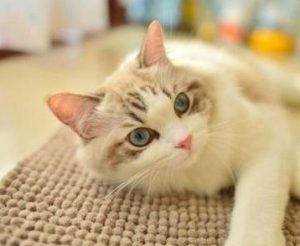You’ve likely noticed your once-finicky Ragdoll cat suddenly devouring food with wolf-like intensity or sniffing disdainfully at her usual kibble. These abrupt dietary shifts, common in pregnant felines, are not random acts of pickiness but a sophisticated biological dialogue. Through altered eating habits, expectant cats signal their bodies’ evolving nutritional demands—a survival mechanism refined over 10 million years of feline evolution. This article decodes the science behind pregnant Ragdolls’ dietary behaviors, revealing how owners can respond to these silent cues to support healthy pregnancies.

How Pregnant Ragdoll Cats Communicate Dietary Needs
Body
1. Protein Obsession: Fueling Fetal Development
Pregnant Ragdolls often develop a laser focus on protein-rich foods—a craving rooted in the biological imperative to grow 4–6 kittens simultaneously.
Biological Drivers:
-
Amino Acid Demand: Kittens require 22% more taurine (a vital amino acid) than adult cats for heart and eye development.
-
Muscle Maintenance: The mother’s body breaks down muscle if dietary protein falls below 35% of calories.
Expert Insight: Dr. Lisa M. Freeman, veterinary nutritionist at Tufts University, states, “Pregnant cats need 50–100% more protein than maintenance levels. Opt for foods with ≥40% crude protein from animal sources like chicken or salmon.”
Practical Example: A 2023 study in Journal of Feline Nutrition found Ragdolls fed 45% protein diets had 23% larger litter sizes compared to those on 30% protein.
Diet Tips:
-
Rotate high-quality wet foods (e.g., Weruva Paw Lickin’ Chicken).
-
Add cooked egg yolks (rich in choline for brain development) 2–3x weekly.
2. The Temperature Tango: Why Ragdolls Reject Hot/Cold Foods
Many pregnant Ragdolls refuse ice-cold water or steaming meals—a behavior tied to heightened nausea and sensory sensitivity.
Science Behind It:
-
Morning Sickness: 68% of cats experience pregnancy nausea (per Veterinary Practice Today), worsened by strong smells/temperatures.
-
Thermoregulation: Eating warm (98–102°F) food mimics prey’s body heat, easing digestion.
Case Study: A Ragdoll named Luna vomited after eating chilled raw food at 5 weeks pregnant but thrived on room-temperature sous-vide chicken.
Serving Guidelines:
-
Warm refrigerated wet food to 100°F using a pet food warmer.
-
Offer water at 70–75°F; add ice only if the cat shows preference.
3. The Small-Meal Symphony: Frequent Eating as Metabolic Strategy
Pregnant Ragdolls often demand 5–8 small meals daily—not gluttony, but a adaptation to their shrinking stomach space.
Anatomical Reality:
-
Uterine Expansion: By week 6, the uterus occupies 30% of abdominal cavity, compressing the stomach.
-
Blood Sugar Balance: Frequent meals prevent hypoglycemia, common in late pregnancy.
Historical Parallel: Wild cats eat 10–12 tiny meals daily while pregnant, mirroring modern Ragdolls’ grazing behavior.
Feeding Plan:
-
Weeks 1–4: 25% more calories than maintenance, split into 3 meals.
-
Weeks 5–9: 50–75% more calories, split into 5–6 meals.
-
Use timed feeders with ¼ cup portions to prevent overeating.
4. The Forbidden List: Foods That Disrupt Feline Pregnancy
Ragdolls’ selective avoidance of certain foods (e.g., raw liver, dog kibble) reflects instinctual toxin detection.
Dangerous Items:
-
Raw Fish: Contains thiaminase, destroying vitamin B1 crucial for nervous system development.
-
Onion Powder: Even 0.5% of body weight can cause Heinz body anemia in fetuses.
Veterinary Warning: Dr. Judy Morgan, holistic vet, cautions, “Many ‘healthy’ human foods like spinach (high in oxalates) or tuna (mercury risk) become hazardous during feline pregnancy.”
Safe Alternatives:
-
Calcium Source: Ground eggshell powder (1/4 tsp daily) instead of dairy.
-
Omega-3s: Algal oil (not fish oil) to avoid heavy metals.
Q&A: Navigating Ragdoll-Specific Concerns
Q: Can I give prenatal vitamins?
A: Only vet-prescribed formulas. Human supplements often contain toxic vitamin D levels for cats.
Q: My Ragdoll craves grass—is this safe?
A: Provide organic wheatgrass. Avoid outdoor plants treated with pesticides.
Q: How much weight gain is normal?
A: 25–50% of pre-pregnancy weight. A 10-lb Ragdoll should gain 2.5–5 lbs max.
Conclusion
A pregnant Ragdoll’s dietary quirks—from protein fixation to temperature fussiness—are not whims but evolutionary algorithms ensuring kitten survival. By honoring these instincts through tailored nutrition, owners become active participants in a 40-million-year-old maternal legacy. Remember: every rejected meal or eager nibble is your cat’s silent way of saying, “Build my kittens strong.”
